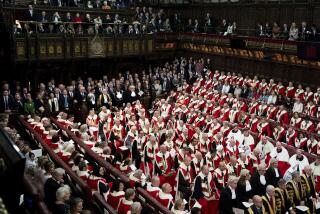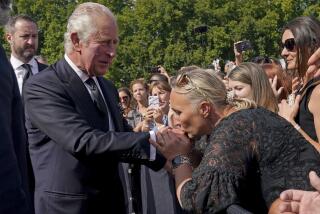Britain Unveils Proposal to Reform House of Lords
- Share via
LONDON — Prime Minister Tony Blair’s Labor government unveiled plans Wednesday to do away with the centuries-old right of British aristocrats to sit in the upper house of Parliament.
Under the proposed reform bill, titled members of the House of Lords--the dukes, earls, viscounts and barons known as hereditary peers--would lose their seats on the red leather benches of the gilded chamber.
Queen Elizabeth II’s husband, Prince Philip, and Prince Charles would be among those no longer entitled to a place in the Palace of Westminster.
In exchange for vacating the House of Lords, hereditary peers would be given the right to vote in parliamentary elections and to run as candidates for the House of Commons without renouncing their titles, as is now required.
At the same time Wednesday, the government announced the establishment of a Royal Commission to draw up a plan for selecting members of the upper house in the future and named Lord Wakeham, a respected member of the Tory opposition, to head it.
“A fundamental anachronism can be removed as we reach the millennium,” said Baroness Jay, who will lead the reform battle once it reaches the House of Lords.
“The presence of the hereditary peerage has weakened the legitimacy and effectiveness of our second chamber. It has weakened it for two main reasons: because the principle is wrong and because the results are unbalanced,” she said.
Currently, 759 of the approximately 1,200 members of the House of Lords have seats solely by virtue of their inheritance of a title. Most of them are older white males. Baroness Jay, on the other hand, is one of the so-called life peers, who are appointed, usually on the basis of merit, and would keep their seats for the transition period at least.
The vast majority of hereditary peers are conservatives, giving the Conservative Party a 3-1 majority in the House of Lords and the Labor Party a major incentive for reform.
Most hereditary peers rarely show up at Westminster, however, and many of those who do say they understand the need to change the 15th century selection process.
But Conservative members are skeptical of the government’s intentions, insisting that Blair aims to create a Labor majority in the House of Lords.
“We are not opposed to reform, but we do oppose these half-baked and self-seeking proposals masquerading as reform,” said Lord Strathclyde, Tory leader in the chamber.
“When we oppose this bill, as we will with vigor, we will do so not because of what is in it but because of what is not in it--that is, the incoherent vision of the future of Parliament,” he said. But the appointment of the 66-year-old Lord Wakeham, a trusted ally of former Prime Minister Margaret Thatcher, to the Royal Commission blunted Tory criticism.
“Society and politics have moved on, and your lordships’ house must, however reluctantly, move with them,” Baroness Jay told the Lords.
Disagreement from the benches was audible when she warned that a “pitched battle” over the reform would quash the government’s willingness to back a compromise that would let some members of the upper house keep their seats for the transitional period.
Last month, it was revealed that the Tories’ leader in the House of Lords, Lord Cranborne, was negotiating with Blair, unbeknownst to Conservative Party leader William Hague, to allow 91 peers to remain in the chamber until a new method of selecting members had been drafted by the Royal Commission and approved by Parliament. Hague sacked Cranborne, but the proposal is still on the table.
The Royal Commission is to report its recommendations at the end of the year.
More to Read
Sign up for Essential California
The most important California stories and recommendations in your inbox every morning.
You may occasionally receive promotional content from the Los Angeles Times.










